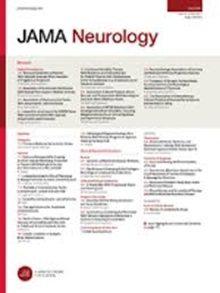Incidence and Prevalence of Frontotemporal Dementia: A Systematic Review and Meta-Analysis.
IF 21.3
1区 医学
Q1 CLINICAL NEUROLOGY
引用次数: 0
Abstract
Importance Comprehensive incidence and prevalence rates of frontotemporal dementia are currently not available. Objective To estimate the incidence and prevalence of frontotemporal dementia and its clinical variants in the overall population and age subgroups. Data Sources and Study Selection We systematically searched PubMed, EMBASE, and Scopus between January 1, 1990, and October 22, 2024, for population-based studies estimating the incidence and/or prevalence of FTD. Data Extraction and Synthesis Studies and data were screened and extracted independently by 2 investigators in accordance with PRISMA guidelines. Incident and prevalent cases together with the population at risk were pooled using random-effects meta-analysis. Differences in heterogeneity by FTD variants and populations at risk were estimated. Main Outcomes and Measures Prevalent and incident cases as numerator were based on well-defined clinical criteria. Denominators were derived either from census population data or from author-defined populations at risk. Results From 1854 screened articles, 32 eligible population-based studies were identified. Sixteen were on prevalence and 22 on incidence reporting FTD measures, including those with estimates for the whole population and for specific age subgroups. Pooled crude incidence for FTD was 2.28 (95% CI, 1.55-3.36) per 100 000 person-years and prevalence, 9.17 (95% CI, 3.59-23.42) per 100 000 people. The behavioral-variant FTD pooled crude incidence was 1.20 (95% CI, 0.67-2.16) per 100 000 person-years and prevalence, 9.74 (95% CI, 2.90-32.73) per 100 000 people. The primary progressive aphasia variant pooled crude incidence was 0.52 (95% CI, 0.35-0.79) per 100 000 person-years and prevalence, 3.67 (95% CI, 3.05-4.43). FTD incidence among individuals younger than 65 years was 1.84 (95% CI, 0.79-4.30) per 100 000 person-years and prevalence, 7.47 (95% CI, 4.13-13.49) per 100 000 people. The denominator based on census data showed less heterogeneity than the population at risk defined by the authors (I2: for incidence, 91.6% vs 97.6%, respectively, and for prevalence, 98.8% vs 99.2%, respectively). Conclusions and Relevance In this systematic review and meta-analysis, estimates indicate that FTD is comparable in frequency to dementia with Lewy bodies and occurs at higher rates than progressive supranuclear palsy, corticobasal syndrome, and amyotrophic lateral sclerosis. These results provide a foundation for future research and public health strategy, especially for underrepresented populations, to better comprehend the global burden of FTD. Our findings provide robust pooled estimates of the incidence and prevalence of FTD and its subtypes, offering a foundation for future research and public health planning.额颞叶痴呆的发病率和患病率:系统回顾和荟萃分析。
目前还没有额颞叶痴呆的全面发病率和患病率。目的评估额颞叶痴呆的发病率和患病率及其临床变异在总体人群和年龄亚群中的分布。数据来源和研究选择我们在1990年1月1日至2024年10月22日期间系统地检索了PubMed、EMBASE和Scopus,以估计FTD发病率和/或患病率的基于人群的研究。数据提取和综合研究和数据由2名研究者根据PRISMA指南独立筛选和提取。使用随机效应荟萃分析将事件和流行病例以及高危人群汇总。估计了FTD变异和高危人群的异质性差异。主要结果和测量方法以确定的临床标准为基础。分母要么来自人口普查数据,要么来自作者定义的高危人群。结果从1854篇筛选的文章中,确定了32项符合条件的基于人群的研究。16项是关于流行率的,22项是关于报告FTD发生率的措施,包括对整个人口和特定年龄亚组的估计。FTD的合并粗发病率为2.28 (95% CI, 1.55-3.36) / 100 000人-年,患病率为9.17 (95% CI, 3.59-23.42) / 100 000人。行为变异的FTD合并粗发病率为1.20 (95% CI, 0.67-2.16) / 100 000人-年,患病率为9.74 (95% CI, 2.90-32.73) / 100 000人。原发性进行性失语症的总发生率为0.52 (95% CI, 0.35-0.79) / 100 000人年,患病率为3.67 (95% CI, 3.05-4.43)。65岁以下人群的FTD发病率为1.84 (95% CI, 0.79-4.30) / 100 000人-年,患病率为7.47 (95% CI, 4.13-13.49) / 100 000人。基于普查数据的分母显示的异质性小于作者定义的高危人群(I2:发病率分别为91.6%和97.6%,患病率分别为98.8%和99.2%)。结论和相关性在这项系统回顾和荟萃分析中,估计表明FTD的发生率与路易体痴呆相当,并且比进行性核上性麻痹、皮质基底综合征和肌萎缩侧索硬化症的发生率更高。这些结果为今后的研究和公共卫生战略提供了基础,特别是针对代表性不足的人群,以便更好地了解口蹄疫的全球负担。我们的研究结果为FTD及其亚型的发病率和患病率提供了可靠的汇总估计,为未来的研究和公共卫生规划提供了基础。
本文章由计算机程序翻译,如有差异,请以英文原文为准。
求助全文
约1分钟内获得全文
求助全文
来源期刊

JAMA neurology
CLINICAL NEUROLOGY-
CiteScore
41.90
自引率
1.70%
发文量
250
期刊介绍:
JAMA Neurology is an international peer-reviewed journal for physicians caring for people with neurologic disorders and those interested in the structure and function of the normal and diseased nervous system. The Archives of Neurology & Psychiatry began publication in 1919 and, in 1959, became 2 separate journals: Archives of Neurology and Archives of General Psychiatry. In 2013, their names changed to JAMA Neurology and JAMA Psychiatry, respectively. JAMA Neurology is a member of the JAMA Network, a consortium of peer-reviewed, general medical and specialty publications.
 求助内容:
求助内容: 应助结果提醒方式:
应助结果提醒方式:


